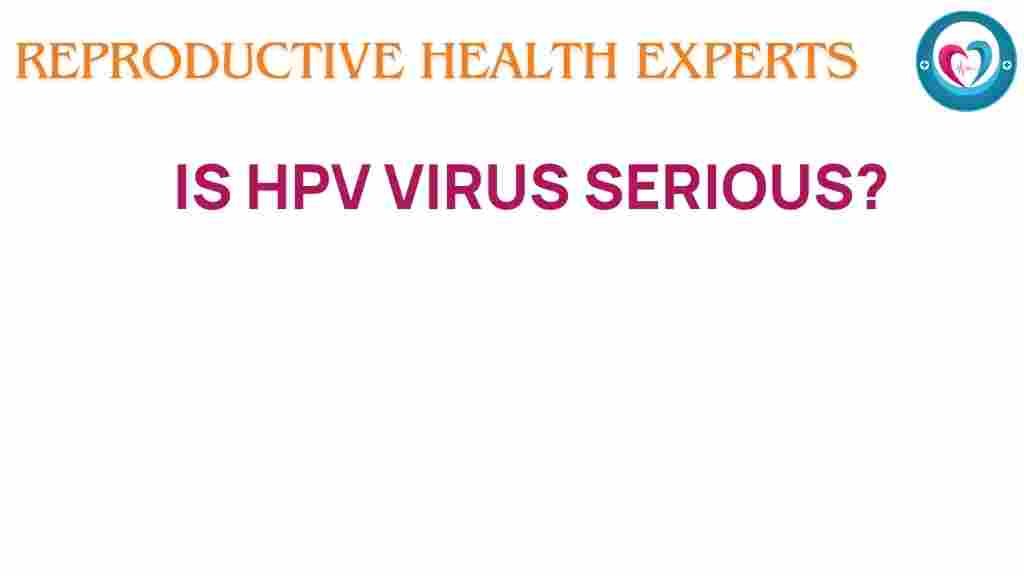Unraveling the Seriousness of the HPV Virus: What You Need to Know
The Human Papillomavirus (HPV) is one of the most common sexually transmitted infections worldwide. With over 100 different types of HPV, it is crucial to understand the health risks associated with this virus, the importance of vaccination, preventive measures, and the potential link to cervical cancer. In this article, we will explore everything you need to know about HPV, its transmission, screening methods, and how to raise awareness about this significant health issue.
Understanding HPV and Its Health Risks
HPV is primarily transmitted through intimate skin-to-skin contact. It can affect anyone who is sexually active, regardless of gender. While most HPV infections resolve on their own without causing any health problems, some types can lead to serious health issues, including:
- Cervical Cancer: HPV is the leading cause of cervical cancer in women.
- Other Cancers: Certain strains of HPV can cause cancers of the vulva, vagina, penis, anus, and oropharynx.
- Genital Warts: Some HPV types cause genital warts, which, while not life-threatening, can be distressing and uncomfortable.
Vaccination: Your Best Defense Against HPV
Vaccination is a powerful tool in the fight against HPV. The HPV vaccine can significantly reduce the risk of developing HPV-related health issues, particularly cervical cancer. Here are some key points about vaccination:
- Who Should Get Vaccinated: The vaccine is recommended for preteens aged 11 to 12, but it can be given as early as age 9 and up to age 26 for those who missed the initial vaccination.
- How Effective Is the Vaccine: Clinical trials have shown that the HPV vaccine is highly effective in preventing infections from the most dangerous types of HPV.
- Types of Vaccines: There are three vaccines available: Gardasil, Gardasil 9, and Cervarix, all of which help protect against the most harmful strains of HPV.
Prevention Strategies to Consider
Aside from vaccination, there are several other strategies to prevent HPV transmission:
- Practice Safe Sex: Using condoms and dental dams can reduce the risk of HPV transmission, although they do not eliminate it entirely.
- Limit Number of Sexual Partners: Reducing the number of sexual partners can lower the likelihood of HPV exposure.
- Regular Health Check-ups: Regular gynecological exams and Pap smears can help detect any changes in cervical cells early, allowing for timely intervention.
Transmission of HPV: What You Should Know
HPV is primarily spread through direct genital contact, but it can also be transmitted through oral and anal sex. Here are some important aspects of HPV transmission:
- Asymptomatic Spread: Many individuals with HPV do not exhibit symptoms, making it easy to unknowingly transmit the virus to partners.
- Duration of Infection: While most HPV infections resolve within two years, some can persist and lead to health complications.
Screening for HPV: Why It Matters
Screening is an essential aspect of managing health risks associated with HPV, especially for women. Here’s what you need to know:
- Pap Smear: This test checks for changes in cervical cells that may indicate HPV infection or precancerous conditions.
- HPV Test: This test can identify the presence of high-risk HPV types that are linked to cervical cancer.
- Follow-up Care: If abnormalities are found, further testing and treatment might be necessary to prevent the development of cervical cancer.
Raising Awareness About HPV
Awareness is crucial in combating HPV and its associated health risks. Here are some ways to promote awareness:
- Education: Provide accurate information about HPV transmission, health risks, and the importance of vaccination.
- Community Outreach: Organize events and workshops that focus on HPV education and prevention.
- Engage Healthcare Providers: Encourage healthcare professionals to discuss HPV with their patients and recommend vaccination and screening.
Troubleshooting HPV Concerns
If you have concerns about HPV, here are some steps you can take:
- Consult Your Doctor: If you’re experiencing symptoms such as unusual genital warts or changes in menstrual cycles, seek medical advice.
- Stay Informed: Keep yourself updated with reliable resources about HPV and its health implications. Resources like the CDC HPV page can be helpful.
- Discuss with Partners: Open communication with sexual partners about HPV and health history is essential for mutual safety.
Conclusion: Taking Action Against HPV
The seriousness of the HPV virus cannot be understated. Understanding its health risks, the importance of vaccination, prevention strategies, and regular screening can significantly reduce the incidence of HPV-related diseases, including cervical cancer. Awareness and education are critical in the fight against HPV transmission. By taking proactive measures, individuals can protect their health and the health of their partners. Stay informed, get vaccinated, and encourage others to do the same.
For more information on HPV prevention and health risks, visit this resource.
This article is in the category Prevention and created by ReproductiveHealthExperts Team
